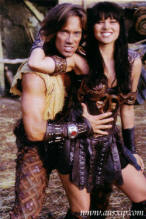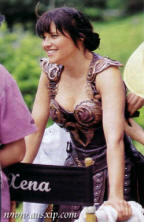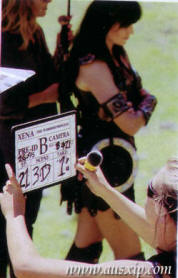 On a
park bathed in buttery New Zealand sunlight, two women, deep in conversation, stroll up a path, tracked by a boom mike and a camera-mounted crane. One is red-haired and diminutive, clothed in a tunic. The other is
zaftig and leggy, dressed like a walking tack shop: leather wrist thongs, leather bicep gauntlets, leather knee pads, leather miniskirt, and a leather bustier embellished by breastplates that look something like swirls
of brass whipped cream. On a
park bathed in buttery New Zealand sunlight, two women, deep in conversation, stroll up a path, tracked by a boom mike and a camera-mounted crane. One is red-haired and diminutive, clothed in a tunic. The other is
zaftig and leggy, dressed like a walking tack shop: leather wrist thongs, leather bicep gauntlets, leather knee pads, leather miniskirt, and a leather bustier embellished by breastplates that look something like swirls
of brass whipped cream.
Suddenly a man bent over a tape recorder starts to joggle his headphones and fiddle with his dials.
"Cut!" calls the director, who turns to the soundman. "Are you getting it?"
"Yeah," says the soundman. "But I've got a little squeaking on Lucy's costume."
Whereupon Lucy Lawless's expression goes from stern cobalt-blue-eyed warrior to smiling showgirl wannabe, and the soundman reaches gingerly to adjust the offending piece of metal on Xena's leather bustier.
"There's a reason she has metal breastplates," says Renee O'Connor—Xena's sidekick, Gabrielle, on the show—"but I don't know what it is."
 The truth is, if Xena's squeaking
breastplates don't make a lot of practical sense, they're a perfect fit in a world where a goddess windsurfing on a giant clamshell can utter the word "tubular," or Hercules (Kevin Sorbo) can buy a falafel sandwich at
the world's first fast-food outlet on a forest path, or Xena can vanquish a half-dozen bad guys in a riverside rumble— using two fish on the end of a string as her weapon of choice. The truth is, if Xena's squeaking
breastplates don't make a lot of practical sense, they're a perfect fit in a world where a goddess windsurfing on a giant clamshell can utter the word "tubular," or Hercules (Kevin Sorbo) can buy a falafel sandwich at
the world's first fast-food outlet on a forest path, or Xena can vanquish a half-dozen bad guys in a riverside rumble— using two fish on the end of a string as her weapon of choice.
Part "Road Warrior," part "7th Voyage of Sinbad"—with a nod to Terry Gilliam and a leering wink at Hugh Hefner—the on-screen world of Hercules: The Legendary Journeys and Xena: Warrior Princess is a place where the
whimsy is as important as the warring. And not surprisingly, the scene behind the scenes Down Under reveals a frenetic and fanciful production world that's delightfully lacking in TV-industry convention, and long on
spontaneity, improvisation, and seat-of-the-pants production.
Casts and crews are stocked with energetic locals on loan from New Zealand's burgeoning film industry, and every suggestion, no matter how off-the-wall, can be fodder for either show.
"We hop around from century to century; we do whatever we want," Sorbo says between takes one day on a Mediterranean village set. "There are no rules. We make fun of ourselves... .I think people are tired of reality. I
mean, ER is great, but I think you want an escape.
"[And] this thing has some sort of formula nothing on TV has right now"— which makes the breakaway success of both Herc and Xena all the more surprising. Traditionally, success in syndication comes to the most
formulaic shows, but Hercules and Xena, in their third and second years, respectively, have climbed through the syndicated rankings to regularly challenge Star Trek: Deep Space Nine, the perennial action-drama king.
 But where DS9 had three decades of
tradition on which to build an audience, Xena and Herc have turned the formulas upside down, starting with the handful of made-for-TV syndicated Hercules movies that Sam Raimi and Rob Tapert, the team behind the
comic-book cinematic stylings of "Darkman" and "Army of Darkness," produced in But where DS9 had three decades of
tradition on which to build an audience, Xena and Herc have turned the formulas upside down, starting with the handful of made-for-TV syndicated Hercules movies that Sam Raimi and Rob Tapert, the team behind the
comic-book cinematic stylings of "Darkman" and "Army of Darkness," produced in
1994. Their success led to the syndicated series (check TV Guide listings for day and time). Now, action figures, comic books, and cartoons are quickly being spun off, and at the end of last season, 44 more episodes of
each show were ordered.
But neither show is resting on its laurels. After a messy shuffling of Hercules' writing staff last spring, prompted by a feud between Sorbo and former head writer John Schulian, Hercules' on-screen demeanor is going
to become a little less heroic, according to executive producer Tapert. Tapert aims to dethrone DS9 once and for all by gradually adding a more dramatic, darker, and mortal dimension to Sorbo's character this winter.
Xena has already been proven eminently mortal—or at least the woman who plays her has. Lawless's spill off a horse during a stunt for The Tonight Show last month (see page 38) resulted in multiple fractures in her
pelvis. But with the fall season's shows already in the can, and Lawless on the mend, there will be no Xenas without Xena this year.
Welcome to the microworld of Hercules and Xena, an operation scattered all over the environs in and around Auckland—chosen for both its distinctive landscape and low production costs. Depending on what the day's script
calls for, filming will span from the beaches to the west to the lush parks of the green-filled city itself. But most of the filming takes place on a 70-acre tract of overgrown vineyard scrub to the south.
From the nearest paved road, the lot is a sprawl of brush and trees, awaiting the inevitable arrival of a housing development like the one springing up nearby. Only the
discerning eye will notice the minarets and parapets poking out of the trees.
A half-mile down a winding dirt road into the vineyard, a visitor discovers, in quick order, a medieval castle, a Moroccan marketplace, a Polynesian village, an army camp of no discernible time or place, and a stage
that looks ominously like a sacrificial altar.
"We wanted a lush environment with a time that's undefinable," producer Eric Gruendemann says. "We try to pollinate our world with every imaginable and available type of person. We wanted to see if we could invent our
own world."
They have clearly succeeded. In the Moroccan set, for instance, the props include a modern hibachi that sits beside an ancient urn. The village streets are prowled by an impressively woolly cast of pierced and hirsute
extras who appear to have been reunited from a Bronze Age Woodstock.
In the meantime, up in the middle of town, two prop shops churn out scimitars and sea monsters as fast as the writers can conjure them. And near the docks, behind the unassuming doors of the historic Auckland Municipal
Markets building, where produce was once auctioned, the shows' cavernous costume department creates as many as 70 original costumes each week. The art directors, costumers, and prop folks working in these quarters have
created an aesthetic texture so distinctive that the shows' art direction has earned praise from Artfo-rum, the glossy bible of the visual world.
On a typical day, costume designer Ngila Dickson sits in her industrial-loft-size shop, surrounded by seamstresses at work. This afternoon, Dickson, the costume designer for the acclaimed 1995 New Zealand film
"Heavenly Creatures," wears a black dress and black stockings. Her hair is black, her skin is white, and her lipstick is the color of the fake blood in a Roger Corman film.
"We always try to have a theme," Dickson says of the costumes she concocts for whatever armies have been written into the scripts. "You have to have some focus: 'Let's make them Neo-Ninja Nazis this week, shall we?'
And away we go." As she speaks, Dickson's fingers idly stroke a rubber battle helmet she's just invented out of a mold made from a pineapple.
And what's planned for the Xena episode on which her staff is frantically working? "It's basically two armies and some priests. It's a bloodbath. Haven't done one of those in a while." Dickson's lips curl into a
crimson smile.
On the floor above, art director Rob Gillies goes about his business of decorating this timeless universe. He considers a rough sketch he'd drawn a couple of days before. A Hercules script had called for a land yacht.
So Gillies thought up a sort of three-wheeled scooter with a huge sail on its back and sent the drawing over to the prop shop—where, three days later, the full-size yacht is wheeled out of the garage by a half-dozen
20-somethings who have worked overtime to get the thing built.
"It'll go 70 kilometers per," says 26-year-old sculptor Chris Fitzpatrick, a member of the prop shop's crew, as he admires the saber-toothed tiger skull he's mounted on the prow of the craft, just in front of a
crossbow-style slingshot. A tour of Fitzpatrick's garage reveals a macabre den, indeed. There's an entire room devoted to swords, on shelves arranged by category: Reptilian, Bony, Mystical.
"Skulls are kind of good," he says with a disturbingly straight face. The chances of the television audience taking note of this meticulous attention to detail are minimal, but to the New Zealanders involved in the
production of both shows, this doesn't matter They're clearly excited to be part of the project, both behind and in front of the camera. New Zealand's best-known Shakespearean actor, Michael Hurst, who plays Hercules'
sidekick, Iolaus. bristles at suggestions that he's slumming on the Hercules set.
"A guy said to me, 'What is a Shakespearean actor doing in a show like this?' I just went, 'Excuse me? I get to do these amazing fights. I get to play love scenes. I get to play comedy. I get to play great scenes of
comradeship and friendship. Does that sound like Shakespeare to you?'
"Of course," he concedes, "it is a little different." Well, a little. The Herc episode in which Iolaus gets to share a hot tub with Xena comes to mind.
We are in the business of selling beautiful images," Lawless says one day over lunch on the Xena set, months before her Tonight Show accident. She's shed the breastplates but is still packed into the leather costume.
Lawless's neon-blue eyes are her most striking physical attribute, although the bustier and short skirt are clearly designed to accentuate some of her others.
"I feel that the show should be, at the most. 15 percent style, 5 percent eye candy, and 80 percent content," she says.
This is not to suggest the native New Zealander doesn't enjoy the attention she's getting for her fairly formidable physical presence. Nonetheless, it's the role's dramatic arc that intrigues Lawless. "For my money,
[it's] the best part for a woman in 30 years of television."
In particular. Lawless relishes the more complicated and ambiguous shades of personality that the writers intentionally visit on Xena. Tapert readily admits that the writers for Lawless's show try to balance every
comedic episode with a dramatic one, while Hercules has tended to offer far lighter and more predictable action fare.
Sorbo is eager to see the formula change.
"I'd like to see more growth in Hercules," he says one day over lunch on the Hercules set. Out of character, Sorbo, a native of Minnesota, is a mild-mannered sort with a self-deprecating sense of humor. "I'd like to
see more dealing with his own personal life. I think there has to be some romantic interest. Make the stakes bigger in the show. I'm beginning to find repetition; I want to be challenged. As an actor I want to make
myself better. Give me a chance to grow. I think there needs to be a bigger story. What's his view? What's his agenda?"
Sorbo's concerns, Tapert says, will soon be addressed, although the producers are limited in how much they can tinker with the formula. The merchandising machine won't tolerate too much of a slackening of Hercules'
godliness, for one thing. For another, there's the demographic to consider. When they developed the show, Raimi and Tapert were aiming at a teenage audience. They hadn't anticipated Herc's popularity with the
preadolescent set.
"We've had him sleep with a woman once, and I got so many letters from parents who'd thought I'd violated something," Tapert says. "It's hard not to pay attention to the parents who trust we aren't going to turn him
into someone promiscuous.
"But I am going to shake up the formula for Hercules for January and February. We're going to do a big romantic arc with Hercules that will air in February. And we're going to play with his godlike powers."
Diehard aficionados need not fear. There will be no toying with the staples of success: This season's Hercules premiere featured Sorbo vanquishing a couple of giant sandworms, and in Xena's impressively gory opener,
Lawless slayed a minotaur using a giant arrow— straight to the chest.
As the saying goes, if it ain't broke, don't fix it. Especially if it's wearing bronze breastplates. ¦ Peter Richmond is a special correspondent far GQ.
XENA'S OH-SO-MORTAL ADVENTURE
In a mythic universe, Xena is quite indestructible. It's only the hazards of modern times—in this case, filming a skit in The Tonight Show's parking lot—that give her trouble. The script called for Lucy Lawless to
arrive on horseback. She was on her third take when the horse's hooves slipped, landing her in the hospital with multiple fractures of her pelvic bone.
"It was like someone pulled the tablecloth out. It all happened so quickly," Lawless said from her Burbank hospital room soon after the October 8 accident. "I knew that I couldn't move my legs. I was lying there in a
fetal position. The next thing I knew, Jay Leno's face flopped into frame, which made me laugh." Lawless has since been inundated with flowers and calls from Leno and various industry types, but has kept all at bay.
"I haven't been keen to have visitors," she said. "I'm sitting here with my hair in a big, ridiculously tangled knot. I have tubes in my arms. The nurse rotates me every two hours. It's not a very good image for a
warrior princess to be seen in a wheelchair sitting on the balcony watching the cars go by." —P.R.
|